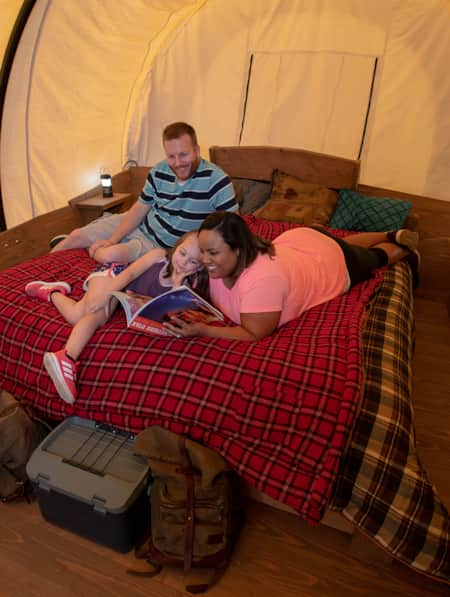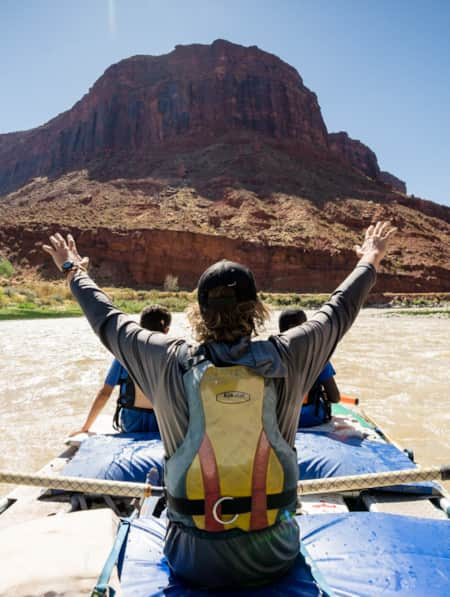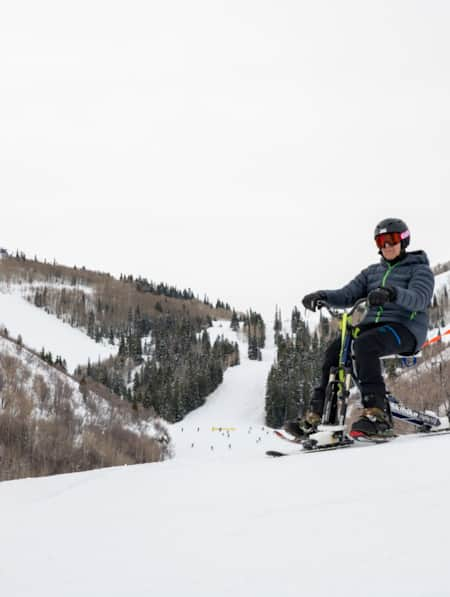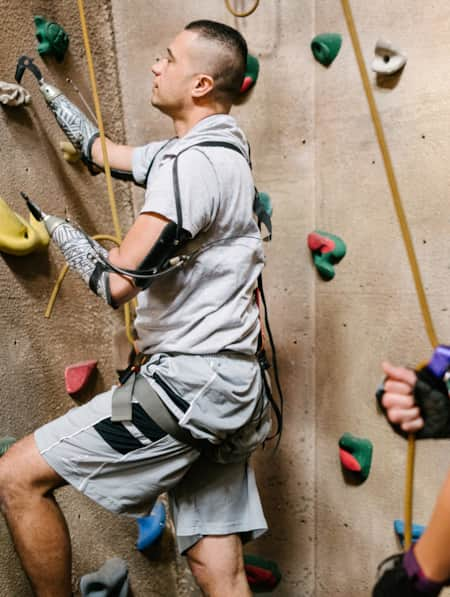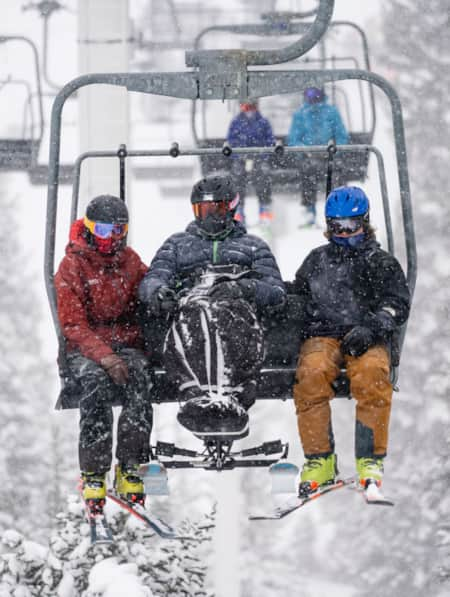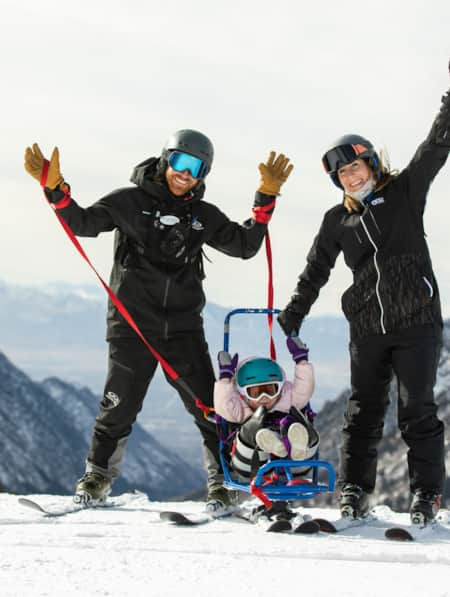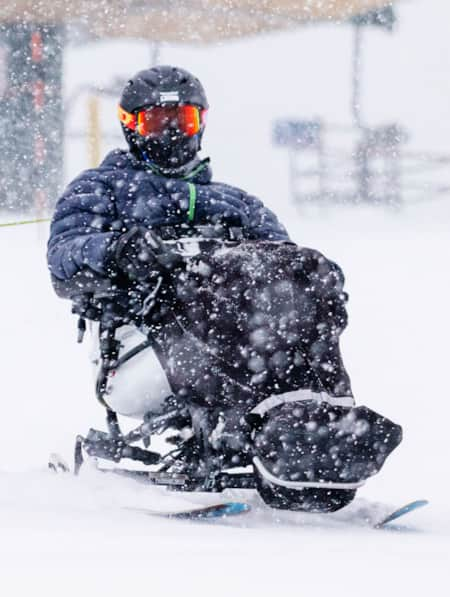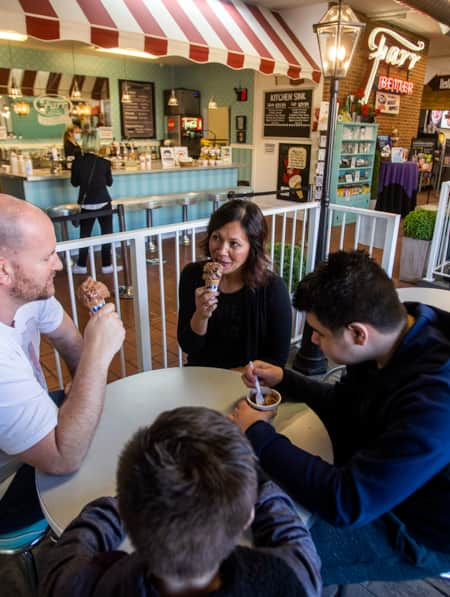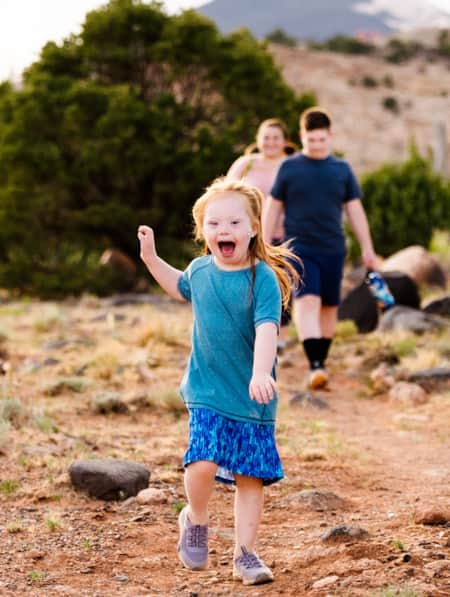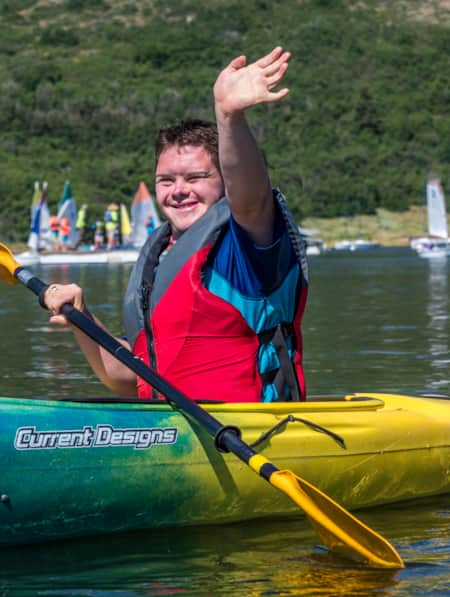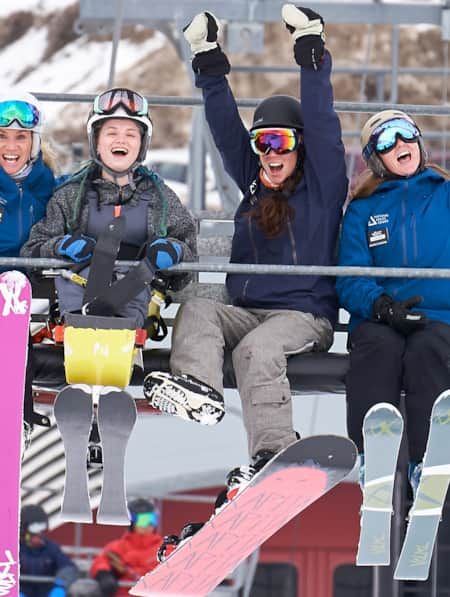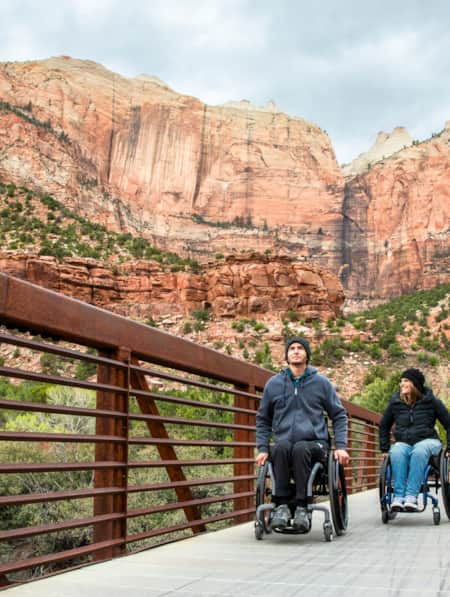Adaptive Cycling in Colorful Cache Valley
Bob Wassom revisits his roots while cycling on an e-trike through Cache Valley; a ride full of color, variety, scenery and history.

In the summer of 1826, the northern Utah region now known as Cache Valley was the scene of a famous rendezvous of mountain men who met to retrieve and trade the furs they had “cached” or hidden between trapping seasons.
These intrepid souls, men like Jim Bridger, Jedediah Smith, Thomas Fitzpatrick and John Weber were the first white visitors to the area. They first came in search of beaver and it became their favorite place to hide their furs, camp and trade their treasures.
One hundred and ninety-three years later, I find myself visiting Cache Valley to retrieve my treasures — the priceless memories I found here 47 years ago — and to honor the family roots I have in this special place. Unlike the mountain men, my mode of transportation is neither by foot nor horse, but on a recumbent e-trike.

Downtown Logan is centrally located in the colorful Cache Valley, a major agricultural, artistic and educational hub in the northwest corner of Utah.
Photo: Scott Markewitz

Bob Wassom survived a paralyzing diving accident in 1972, regaining partial use of his arms and legs which he puts to good use on Utah’s outdoor playground.
Photo: Scott Markewitz
An emotional homecoming.
My journey is a homecoming of sorts. I plan to cycle Cache Valley’s country roads and bike trails amid the fall colors, while revisiting the town and university where my life changed in so many ways. I’m accompanied by my wife Jayne and photographer Scott Markewitz.
The recumbent e-trike is a recent switch from a two-wheel bike to compensate for waning balance and strength from an aging spinal cord injury. Without this new technology, I’d be sitting on the sidelines.
Logan is 82 miles north of my home in Salt Lake City via I-15 and US Highway 89/91 through Box Elder/Wellsville Canyon, which the locals call Sardine Canyon. There’s no definitive reason why it’s called Sardine. Some say it’s because early travelers were packed in like sardines in transit, others say it’s because they ate sardines on their way through the canyon and left the packages along the way.
While it’s a mere 90 minutes from my home, whenever I get my first glimpse of the expansive and verdant Cache Valley laid out before me, I feel light-years removed from the everyday grind. A feeling of well-being washes over me and my grip on the steering wheel lightens. Memories of college days at Utah State University flood my senses.
On this trip however, my mind doesn’t linger and immediately turns to which cycling route I’ll try first. This will be the maiden Cache Valley voyage of my e-trike.
A road for every cyclist.
The valley is a road cyclist’s paradise. As a long-time participant in the Multiple Sclerosis Society’s MS 175 Bike Ride, I’ve circumvented the valley on country roads bordered by green fields, quiet farms and tree-lined neighborhoods. Most are relatively flat, with a few climbs here and there to keep you humble.
The 50-mile long valley is bordered on the west by the imposing Wellsville Mountains, considered by some to be the steepest mountain range in the United States, and by the Bear River Range on the east, with its many canyons inviting exploration.
The valley is also home to Little Red Riding Hood, a non-competitive women-only cycling event that raises money for the fight against cancer in women. Further, Logan is home to, the grueling 203-mile Logan to Jackson Hole bike race that is the longest one-day event in the country.
I decided to try Blacksmith Fork Canyon in search of red and orange fall colors. I also wanted to experience the extended freedom of an electric motor in a challenging canyon I had not attempted before now. While not too steep, the 17-mile canyon is known for its headwinds in both directions.
The colors were not as vibrant as expected but as soon as the wheels hit the road and the pedals began to turn, it didn’t matter. My low-slung, pedal assist e-trike cut through the wind and I rushed alongside Blacksmith Fork River trimmed with gold and orange autumn leaves until the unseasonably cold temperatures turned me back towards the car.
It didn’t matter that I hadn’t navigated the entire 17-mile canyon road, although there’s a reward at the top in the Hardware Ranch Wildlife Management Area. In the summer, it provides great wildlife viewing, ATV trails and access to the Monte Cristo wilderness. In the winter, there’s a huge (up to 700) Rocky Mountain Elk herd and horse drawn sleigh for viewing them up close.
But I had other cycling destinations in mind. On to Hyrum Reservoir.

Willow, box elder and maple trees surround Hyrum Reservoir providing shade as well as habitat for waterfowl and wildlife.
Photo: Scott Markewitz

Utah State University's campus has a historical charm and many public educational offerings including museums and galleries.
Photo: Scott Markewitz
A life-changing destination.
In terms of life-changing places, this is at the top of my list. It’s where I dove into the water, hit a submerged tree stump headfirst, broke my neck and was instantly paralyzed from the neck down. An afternoon lark with some Sigma Chi brothers turned me into a quadriplegic.
Fortunately, I had not completely severed my spinal cord, just seriously damaged it. In time I was able to regain the use of my arms and legs, to about 60% of normal. Within a few years, I was back skiing and cycling, though at a much-reduced level of performance than in my able-bodied days.
Now, with age, I’m losing strength and balance, prompting the switch to adaptive equipment like trekking poles for walking, recumbent trikes for cycling and ski-bikes for skiing. Thanks to these technological advancements, I’m still out there enjoying Mother Nature’s playground.
Riding past the shimmering blue reservoir rimmed with yellow and orange trees was emotional — a bit of sadness, but mostly gratitude. I’ll never forget the split second that changed my life forever. But there’s no room in my life for bitterness or resentment. After all, I’m still riding.
A lap around the reservoir and I was ready to move on to my next cycling venue: the USU campus. While the site of my college education was hardly a serious bike (or trike) ride, its scenic beauty and family legacy made it a command performance.
The family roots are deep.
The family connection to USU and Cache Valley? My great-grandfather Marriner W. Merrill helped found Richmond and the Cache Valley dairy industry by starting a condensed milk factory that eventually became the largest Sego Milk factory west of the Mississippi. He became an Apostle for the Church of Jesus Christ of Latter-Day Saints and was the first president of the Logan Temple. And my father, born in 1921 in the town of Tremonton 23 miles away, helped clear rocks off Old Main hill so they could plant grass while he was a student at USU. Shortly thereafter, he transferred to the University of Utah on a basketball scholarship, where he met my mother.
I began my campus tour by pedaling up the wide, steep walkways of Old Main hill, the immense tree-covered grassy hill on the west side of Old Main, the iconic landmark that is the epicenter of the original land grant university established in 1888.
No doubt I left quite an impression on the variety of students I passed on their way home from class: all 6 feet 3 inches of me, clad in bright red and black on my atomic orange Catrike, my extra-long legs pushing knees skyward with each pedal stroke. Not your typical commuter.
Once on top of the hill, I continued eastward around Old Main to The Quad, a multi-acre grassy field divided into four quadrants and surrounded by the original buildings of the “AC.” As I rode across this historic acreage, I couldn’t help but reflect upon the astounding transformation of the home of the Aggies.

Founded in 1888 and originally known as Utah Agricultural College, Utah State University continues to bring forward ground breaking research in areas of agriculture, technology, education, and more recently, outer space exploration.
Photo: Scott Markewitz

Photo: Scott Markewitz
From agriculture to space exploration.
The original Utah State University known for agricultural and dairy science could also be known as Utah Space University. Through its world-renowned Space Dynamics Laboratory, USU has sent more student-built projects into space than any university in the world. USU is also the number two university in the United States when it comes to funding for space research.
I know this because my brother, Dr. Steve Wassom, a Cache Valley resident, has a Ph.D. in Mechanical & Aerospace Engineering from USU and is literally a rocket scientist who worked for 13 years at the Space Dynamics Laboratory. He now travels the country as a part of a mission assurance team that prepares and supports launches of government payloads into space.
Not just another ride.
As I pedaled across campus amid the fall colors, it became clear that this was not just another ride. My e-trike was my time machine, taking me on a reflective look back at my alma mater where I received my college degree, joined Sigma Chi fraternity and found my wife, the former Jayne Smith at the Chi Omega house next door. Jayne’s mother Gretta was the Cache County Recorder for three decades. Yes, the Cache Valley roots are deep.
The final stop on my tour was Beaver Mountain Ski Resort, where I taught skiing prior to my accident. I got there by car, not trike, due to the 30-mile drive and 18-degree temperatures. I’m hardy but not fool-hardy. Another family connection: Jayne’s brother Bob Smith was very close to the Seeholzer family who founded the resort and worked there as a young man, helping Harry Seeholzer make Beaver Mountain a reality. Established in 1949, Beaver Mountain is stilled owned by the Seeholzer’s, making it the oldest family-owned resort in the country.
Cycling Cache Valley, no matter the time of year, is full of color, variety, scenery and history (Read: Cache Valley’s Rich Past and Thriving Present). Wide open country roads, tree-lined canyons and quiet neighborhoods are all readily accessible, even for someone on a three-wheeled e-trike. While you may not have the memories to revisit when you arrive like I did, I promise you’ll have more than a few when you leave.
What's Nearby
-

Bear Lake State Park
Bear Lake is a 20-mile long and eight-mile wide natural lake with beautiful, placid waters that perfectly match the tranquil pace of the quaint towns that dot the shore. The northern half is located in Idaho and the southern half in Utah with the state lines dividing it.
-

Brigham City
Brigham City's Main Street archway proclaims "Gateway to the World's Greatest Wild Bird Refuge." Brigham City boasts a small-town feel with big-city amenities like comfortable and affordable hotel rooms, deluxe suites, and beautiful golf courses.
-

Logan
The Logan area hosted the Shoshone tribe’s ancestral hunting for thousands of years and is still home to great examples of early Mormon pioneer architecture, including the Temple and Tabernacle.




